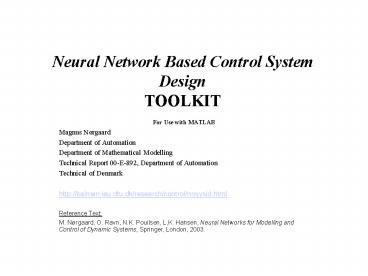Neural Network Based Control System Design TOOLKIT - PowerPoint PPT Presentation
1 / 12
Title:
Neural Network Based Control System Design TOOLKIT
Description:
Neural Network Based Control System Design TOOLKIT For Use with MATLAB Magnus N rgaard Department of Automation Department of Mathematical Modelling – PowerPoint PPT presentation
Number of Views:483
Avg rating:3.0/5.0
Title: Neural Network Based Control System Design TOOLKIT
1
Neural Network Based Control System
DesignTOOLKIT
- For Use with MATLAB
- Magnus Nørgaard
- Department of Automation
- Department of Mathematical Modelling
- Technical Report 00-E-892, Department of
Automation - Technical of Denmark
- http//kalman.iau.dtu.dk/research/control/nnsysid.
html - Reference Text
- M. Nørgaard, O. Ravn, N.K. Pouilsen, L,K. Hansen,
Neural Networks for Modelling and Control of
Dynamic Systems, Springer, London, 2003.
2
Single Input Single Output (SISO)
- Time Domain vs. Frequency Domain
- Regulators vs. Servos
- The primary function of a regulatory system is
to maintain a constant value of the controlled
variable or system output even in the event of
severe load inputs. - In processing industries most processes can be
considered self regulating and have many first
order time constants in series as well as a
significant dead time between the time the
manipulated variable is changed and any change is
detected in the process. - A servo-system is normally subjected to a
continuously varying command signal or set point
its primary function, causing the output to
follow the command signal.
3
Servo
Regulator
4
Neural Network for Control
- Inverted neural network controls have been used
principally for servo applications. - The concept of neural network control is if a
neural network model can be defined for the
process, this model can be inverted and the
inverted model can be used for control. - This should be used only when the process is so
complex or non linear that conventional controls,
such as PID, cannot be used. - There is a serious word of caution with using
this technique. Because the neural network uses
trained parameters and not first order
principals, the network will not give guaranteed
performance within any region where it was not
trained. Interlocks should be used to safely
shutdown the process in event of any malfunction.
5
An example of this technique is shown below, a
conical tank level control
6
The tank level is a highly non linear process,
the outlet flow being a function of the square
root of the head while the inlet level change is
a function of the inverted square of the
head Watch out for zero head!
7
The inverted neural network and control system
are shown as follows
8
An example of the result of a trained network is
shown below
9
In order to avoid model offsets, an improved
method would be to add a PI controller before the
network.The output of this controller should be
scaled to the reference input range. The reset
term in the PI controller will act as a bias to
offset network inaccuracies.
10
Neural Networks as Compensating Blocks
- ISA article by Dumbie uses a feed forward block
in the output signal to the final controller's
setpoint. - The example Temperature controller of a tempered
water system with a cold and hot streams mixed.
Total flow and temperature of the combined
streams are the interactive controls.
11
Compensating Feed Forward Blocks
- The combined temperature in this equation is the
output of the temperature controller Tw'
12
Note that the Tw is the controller output, that
is scaled the same as the PV or controller
inputAn alternate to this is to develop a
neural network, inverted, that acts as a feed
forward compensating blockThis technique is
also used by Rhinehart for distillation control































